1994 CHEVROLET BLAZER warning light
[x] Cancel search: warning lightPage 186 of 348
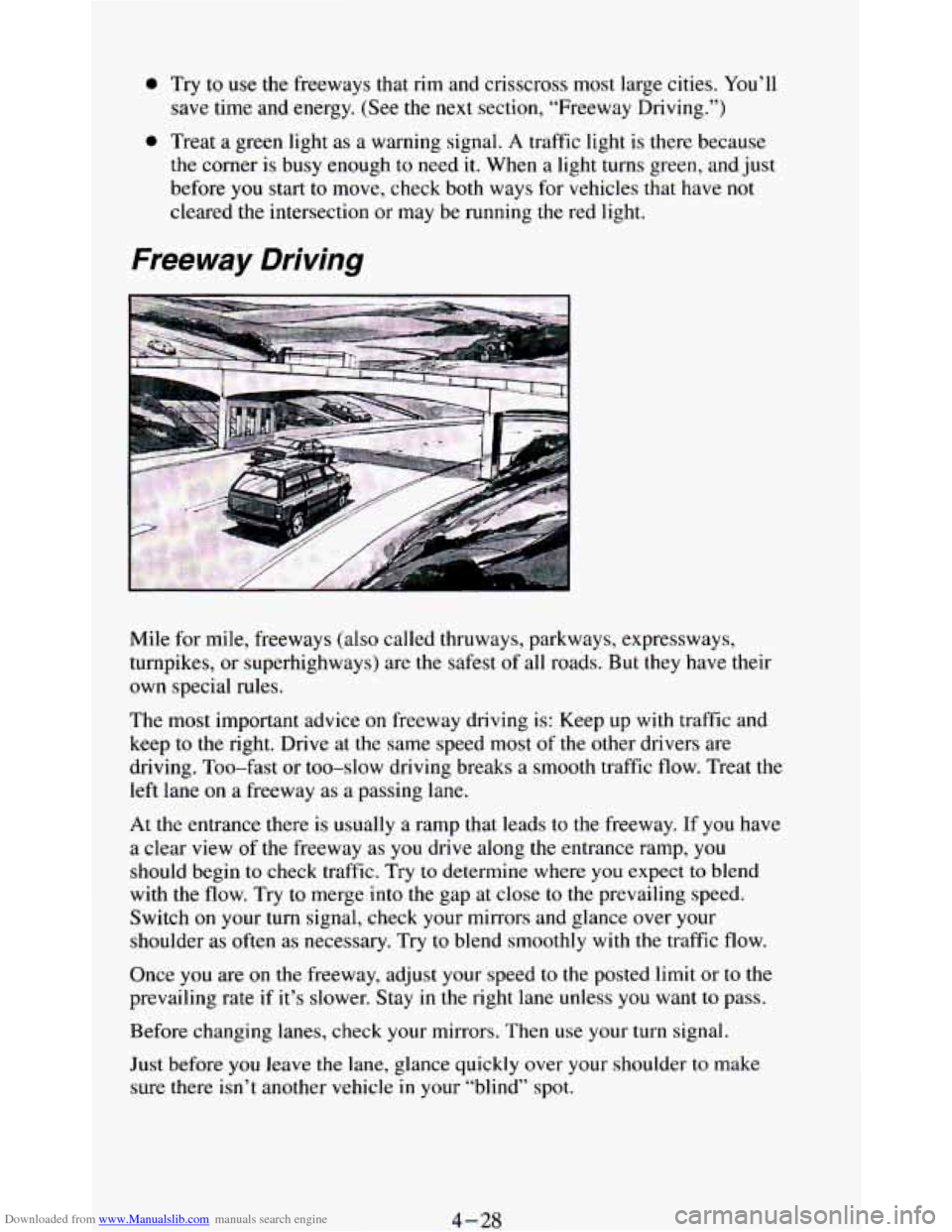
Downloaded from www.Manualslib.com manuals search engine 0 Try to use the freeways that rim and crisscross most large cities. You’ll
save time and energy. (See the
next section, “Freeway Driving.”)
0 Treat a green light as a warning signal. A traffic light is there because
the corner
is busy enough to need it. When a light turns green, and just
before
you start to move, check both ways for vehicles that have not
cleared the intersection or may be running the red light.
Freeway Driving
-.
Mile for mile, freeways (also called thruways, parkways, expressways,
turnpikes, or superhighways) are the safest of all roads. But they have their
own special rules.
The most important advice on freeway driving is: Keep up with traffic and
keep to the right. Drive at the same speed most of
the other drivers are
driving. Too-fast or too-slow driving breaks
a smooth traffic flow. Treat the
left lane
on a freeway as a passing lane.
At the entrance there is usually a ramp that leads to the freeway.
If you have
a clear view of the freeway as
you drive along the entrance ramp, you
should begin to check traffic. Try
to determine where you expect to blend
with the flow. Try to merge into
the gap at close to the prevailing speed.
Switch
on your turn signal, check your mirrors and glance over your
shoulder as often as necessary. Try
to blend smoothly with the traffic flow.
Once you are
on the freeway, adjust your speed to the posted limit or to the
prevailing rate if it’s slower. Stay in the right lane unless you want to pass.
Before changing lanes, check your mirrors. Then use your turn signal.
Just before
you leave the lane, glance quickly over your shoulder to make
sure there isn’t another vehicle
in your “blind” spot.
4-28
Page 190 of 348
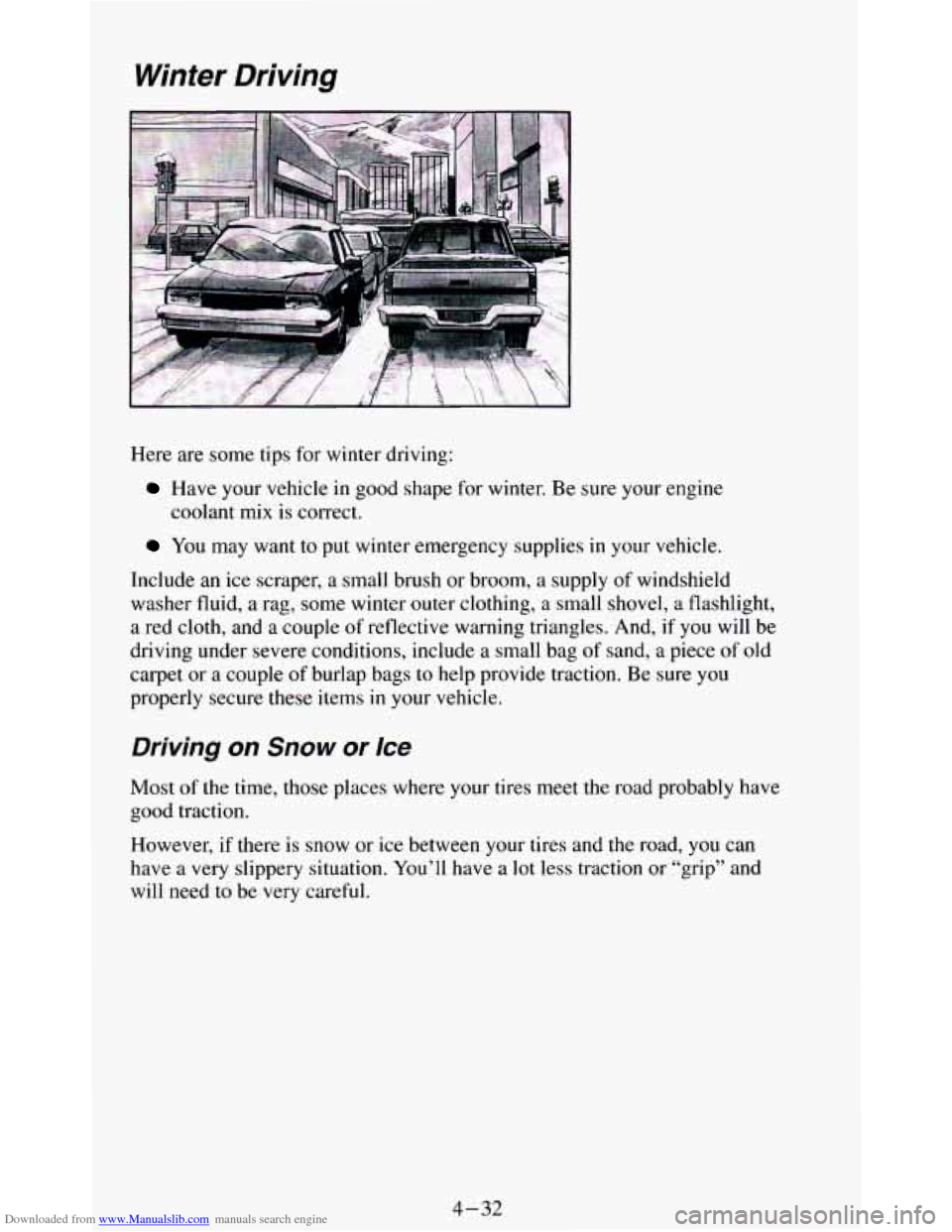
Downloaded from www.Manualslib.com manuals search engine Winter Driving
Here are some tips for winter driving:
Have your vehicle in good shape for winter. Be sure your engine
coolant mix is correct.
You may want to put winter emergency supplies in your vehicle.
Include
an ice scraper, a small brush or broom, a supply of windshield
washer fluid,
a rag, some winter outer clothing, a small shovel, a flashlight,
a red cloth, and a couple
of reflective warning triangles. And, if you will be
driving under severe conditions, include a small bag of sand,
a piece of old
carpet
or a couple of burlap bags to help provide traction. Be sure you
properly secure these items in your vehicle.
Driving on Snow or /ce
Most of the time, those places where your tires meet the road prob\
ably have
good traction.
However, if there
is snow or ice between your tires and the road, you can
have a very slippery situation. You’ll have a
lot less traction or “grip” and
will need to be very careful.
4-32
Page 204 of 348

Downloaded from www.Manualslib.com manuals search engine Hazard Warning Flashers
Your hazard warning
flashers let
you warn
others. They also let
~ police know you have
1 a problem. Your front
and rear turn signal
lights will flash
on
and off.
Press the button in to
make your front and
rear turn signal lights
flash on and
off. Your
hazard warning
flashers work no matter what position
your key is
in, and
even
if the key isn’t in.
To turn off the
flashers,
pull out on
the collar.
When the hazard
warning flashers are
on, your turn signals
won’t work.
5-2
Page 249 of 348
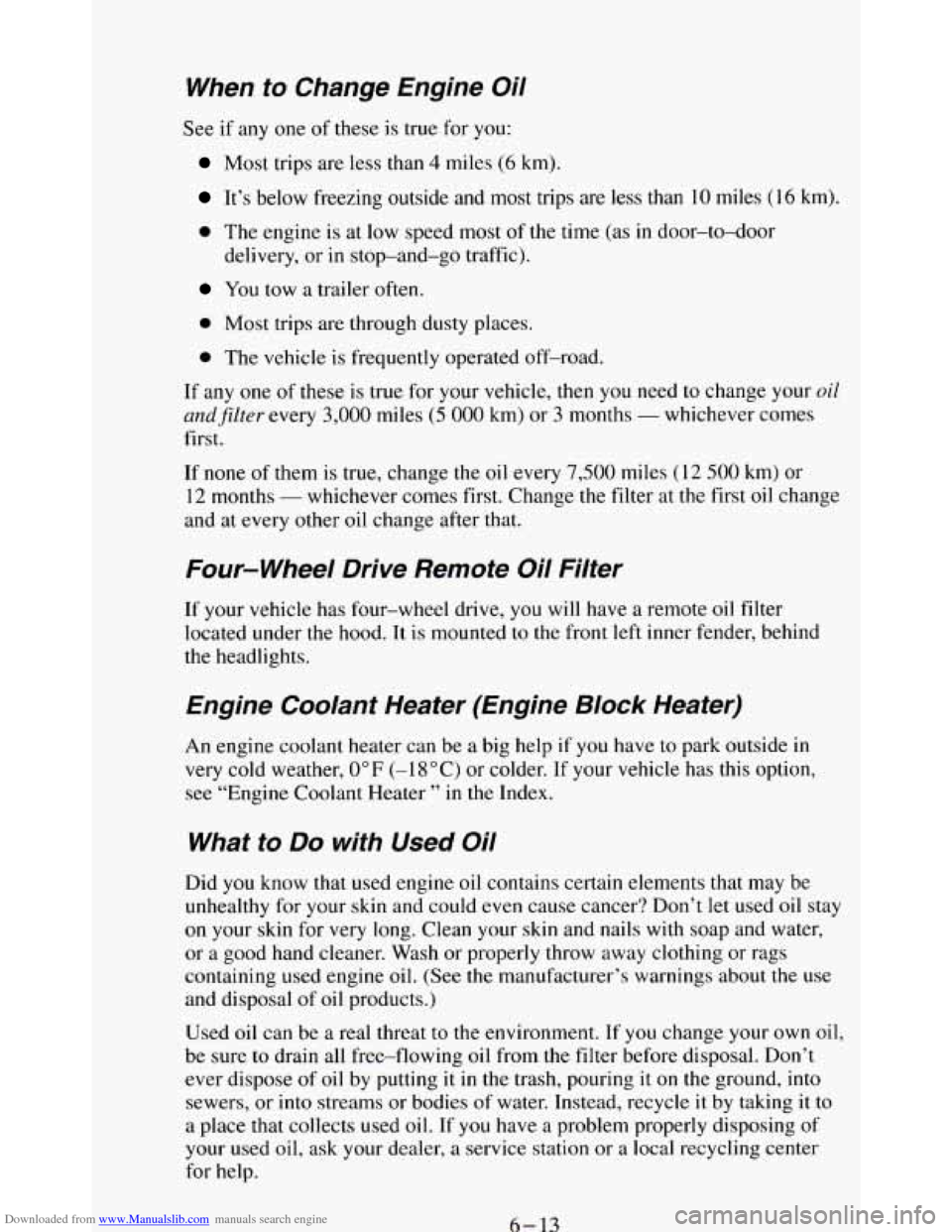
Downloaded from www.Manualslib.com manuals search engine When to Change Engine Oil
See if any one of these is true for you:
Most trips are less than 4 miles (6 km).
It’s below freezing outside and most trips are less than 10 miles (I 6 km).
0 The engine is at low speed most of the time (as in door-to-door
delivery, or
in stop-and-go traffic).
You tow a trailer often.
0 Most trips are through dusty places.
0 The vehicle is frequently operated off-road.
If any one of these is true for your vehicle, then you need to change your oil
andfilter every 3,000 miles (5 000 km) or 3 months - whichever comes
first.
If none
of them is true, change the oil every 7,500 miles (12 500 km) or
12 months - whichever comes first. Change the filter at the first oil change
and at every other oil change after that.
Four-wheel Drive Remote Oil Filter
If your vehicle has four-wheel drive, you will have a remote oil filter
located under the hood. It is mounted to the front left inner fender, behind
the headlights.
Engine Coolant Heater (Engine Block Heater)
An engine coolant heater can be a big help if you have to park outside in
very cold weather, 0°F (-18°C) or colder. If your vehicle has this option,
see “Engine Coolant Heater
” in the Index.
What to Do with Used Oil
Did you know that used engine oil contains certain elements that may be
unhealthy for your skin and could even cause cancer? Don’t let used oil stay
on your skin for very long. Clean your skin
and nails with soap and water,
or
a good hand cleaner. Wash or properly throw away clothing or rags
containing used engine oil. (See
the manufacturer’s warnings about the use
and disposal of oil products.)
Used oil can be
a real threat to the environment. If you change your own oil,
be sure to drain all free-flowing oil from
the filter before disposal. Don’t
ever dispose of oil
by putting it in the trash, pouring it on the ground, into
sewers, or into streams or bodies of water. Instead, recycle
it by taking it to
a place that collects used oil. If you have a problem properly disposing of
your used oil, ask your dealer,
a service station or a local recycling center
for help.
6-13
Page 259 of 348
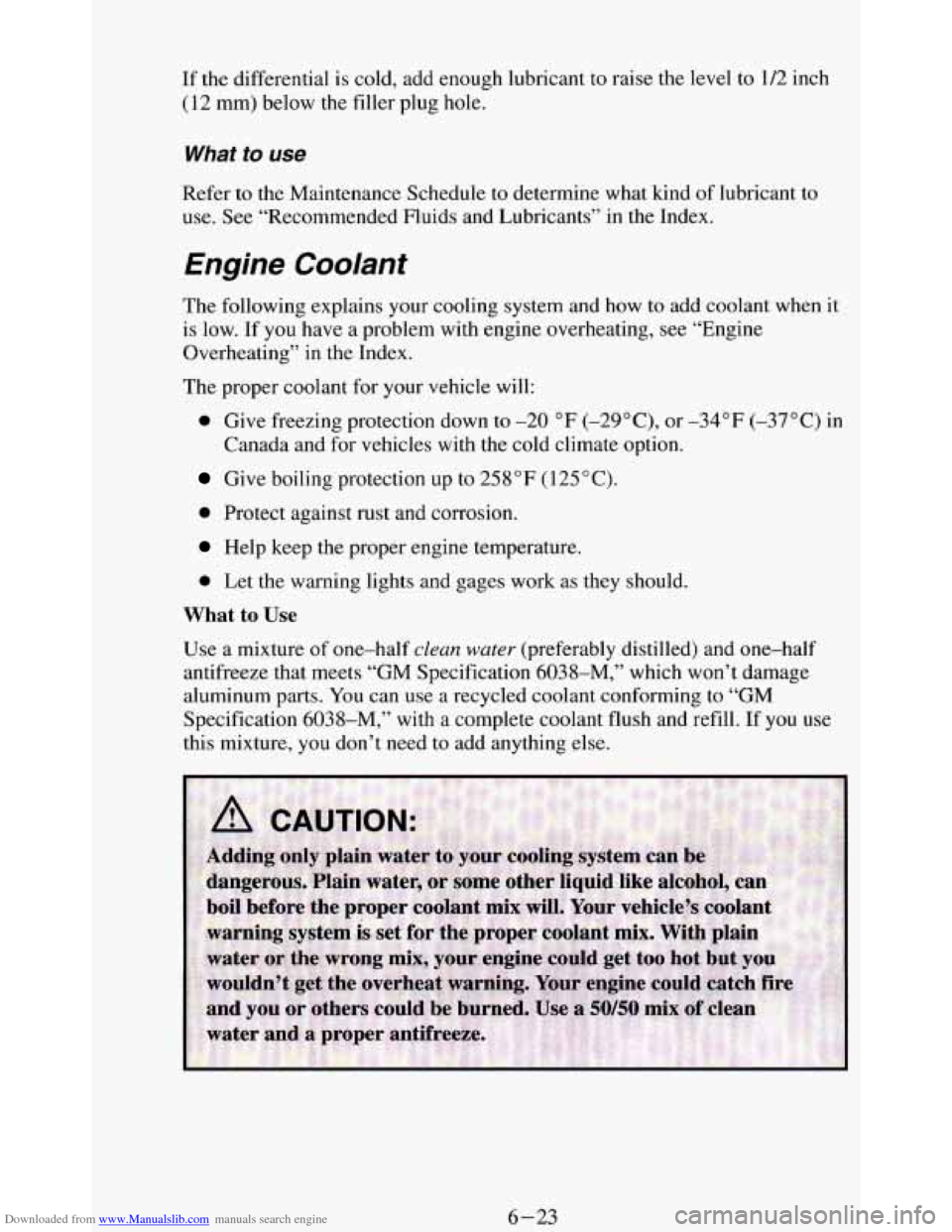
Downloaded from www.Manualslib.com manuals search engine If the differential is cold, add enough lubricant to raise the level to 1/2 inch
(12 mm) below the filler plug hole.
What to use
Refer to the Maintenance Schedule to determine what kind of lubricant to
use.
See “Recommended Fluids and Lubricants” in the Index.
Engine Coolanr
The following explains your cooling system and how to add coolant when it
is
low. If you have a problem with engine overheating, see “Engine
Overheating” in the Index.
The proper coolant for your vehicle will:
0 Give freezing protection down to -20 “F (-29”C), or -34°F (-37°C) in
Give boiling protection up to 258°F (125°C).
Canada
and for
vehicles with the cold climate option.
0 Protect against rust and corrosion.
Help keep the proper engine temperature.
0 Let the warning lights and gages work as they should.
What to Use
Use a mixture of one-half clean water (preferably distilled) and one-half
antifreeze that meets “GM Specification 6038-M,” which won’t damage
aluminum parts.
You can use a recycled coolant conforming to “GM
Specification 6038-M,” with a complete coolant flush and refill. If you use
this mixture, you don’t need to add anything else.
6-23
Page 300 of 348
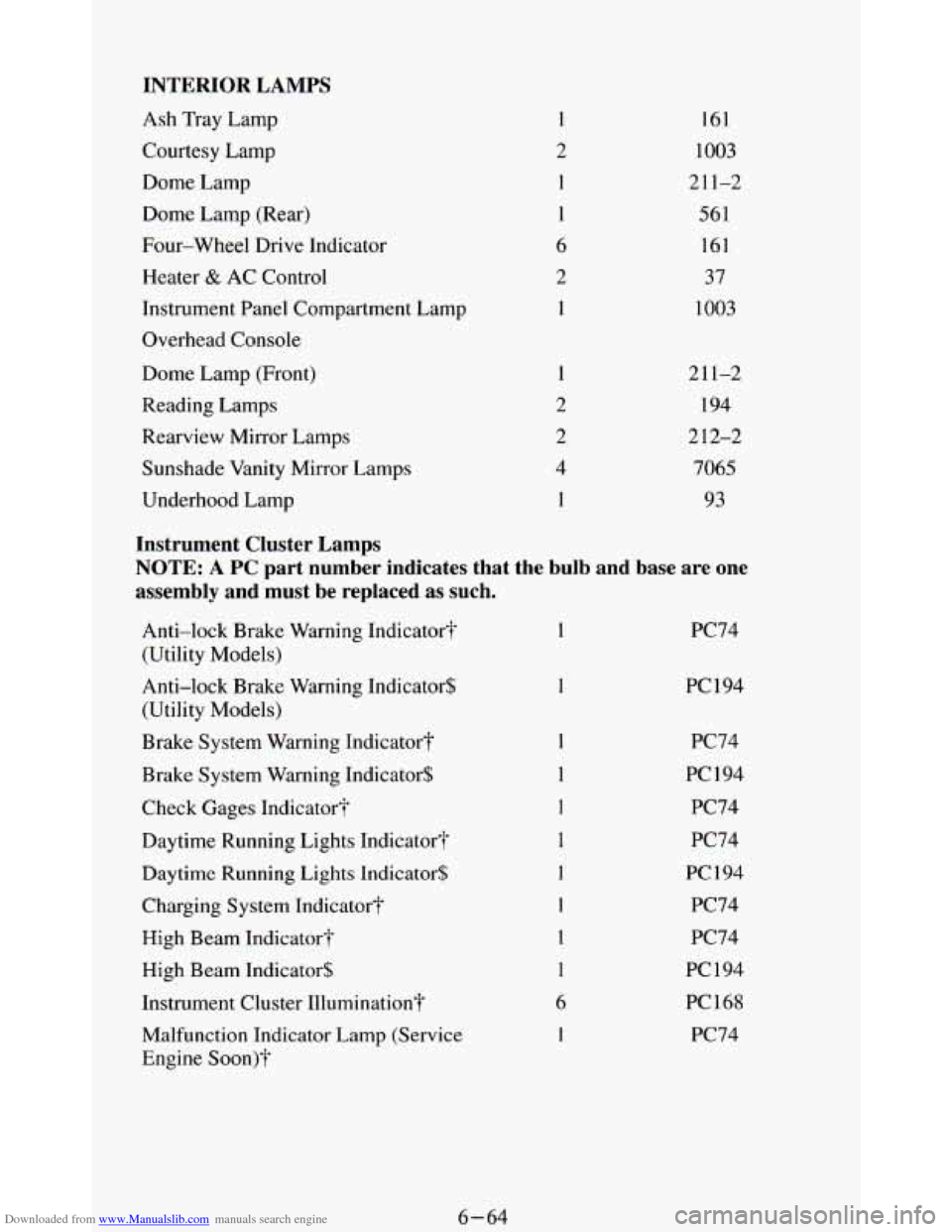
Downloaded from www.Manualslib.com manuals search engine INTERIOR LAMPS
Ash Tray Lamp
Courtesy Lamp
Dome Lamp Dome Lamp (Rear)
Four-wheel Drive Indicator
Heater
& AC Control
Instrument Panel Compartment Lamp
Overhead Console
Dome Lamp (Front)
Reading Lamps
Rearview Mirror Lamps
Sunshade Vanity Mirror Lamps
Underhood Lamp
161
1003
21 1-2
561
161
37
1003
211-2 194
2 12-2
7065 93
Instrument Cluster Lamps
NOTE:
A PC part number indicates that the bulb and base are one
assembly and must be replaced as
such.
Anti-lock Brake Warning Indicator?
(Utility Models)
Anti-lock Brake Warning Indicator$
(Utility Models)
Brake System Warning Indicator?
Brake System Warning Indicator$
Check Gages Indicator?
Daytime Running Lights Indicator’f
Daytime Running Lights Indicator$
Charging System Indicator?
High Beam Indicator?
High Beam Indicator$
Instrument Cluster Illumination?
Malfunction Indicator Lamp (Service
Engine Soon)?
1
1
1
1
1
I
1
1
1
6
1
PC74
PC 194
PC74
PC 194
PC74
PC74
PC 194
PC74
PC74
PC 194
PC168 PC74
6-64
Page 303 of 348

Downloaded from www.Manualslib.com manuals search engine NAME
INST LPS
PWR ACC
HORN-DM
BATT
STOP-HAZ
TAIL LMPS
ECM B
CIRCUITS PROTECTED
FUSE CIRCUIT
BREAKER
Instrument Panel Lights,
Headlight Warning Buzzer,
Rear Defogger Switch Light,
Four-wheel Drive Indicator
Light, RR Wiper Switch
Lamp, Fog Lamp Switch
Light, Electronic Shift Pnl
Lamps
Power Door Locks, Rear
Defogger, Electric Shift
Transfer Case, Power Seat
Horn, Dome Lights, Courtesy
20 Amp
Lights, Fog Lamp Relay,
Outside Rearview Mirror,
Liftgate Release Solenoid,
ISRV
& Lighted Vanity
Mirror, IP Compr Lamps, Cig
Lighter
IGN-GAGES Indicator Lights and Gages,
Rear Defogger Relay, Cruise
Control, Four Wheel Drive
Indicator Light, Rear
Defogger Timer, Seat Belt
Timer,
02 Sensor, VTC Relay,
Auto Trans, RR Defog
Switch,
0 Spd Warning
(Export),
DRL Relay, ISRV
and Vanity
Stop Lights, Hazard Flasher
Warning Lights, Chime
Module
Light Switch, Tailpark
Lights, Digital Cluster,
License Lamp
TURN-B/U Turn Signals
& Backup Lights 15 Amp
HEATER A/C Heating and Air Conditioning
25 Amp
RADIO Radio, Rear Wiper, Rear
15 Amp
Washer
Engine Control Module, Fuel
15 Amp
Pump
5 Amp
30 Amp
20 Amp
15 Amp
20 Amp
6-67
Page 337 of 348
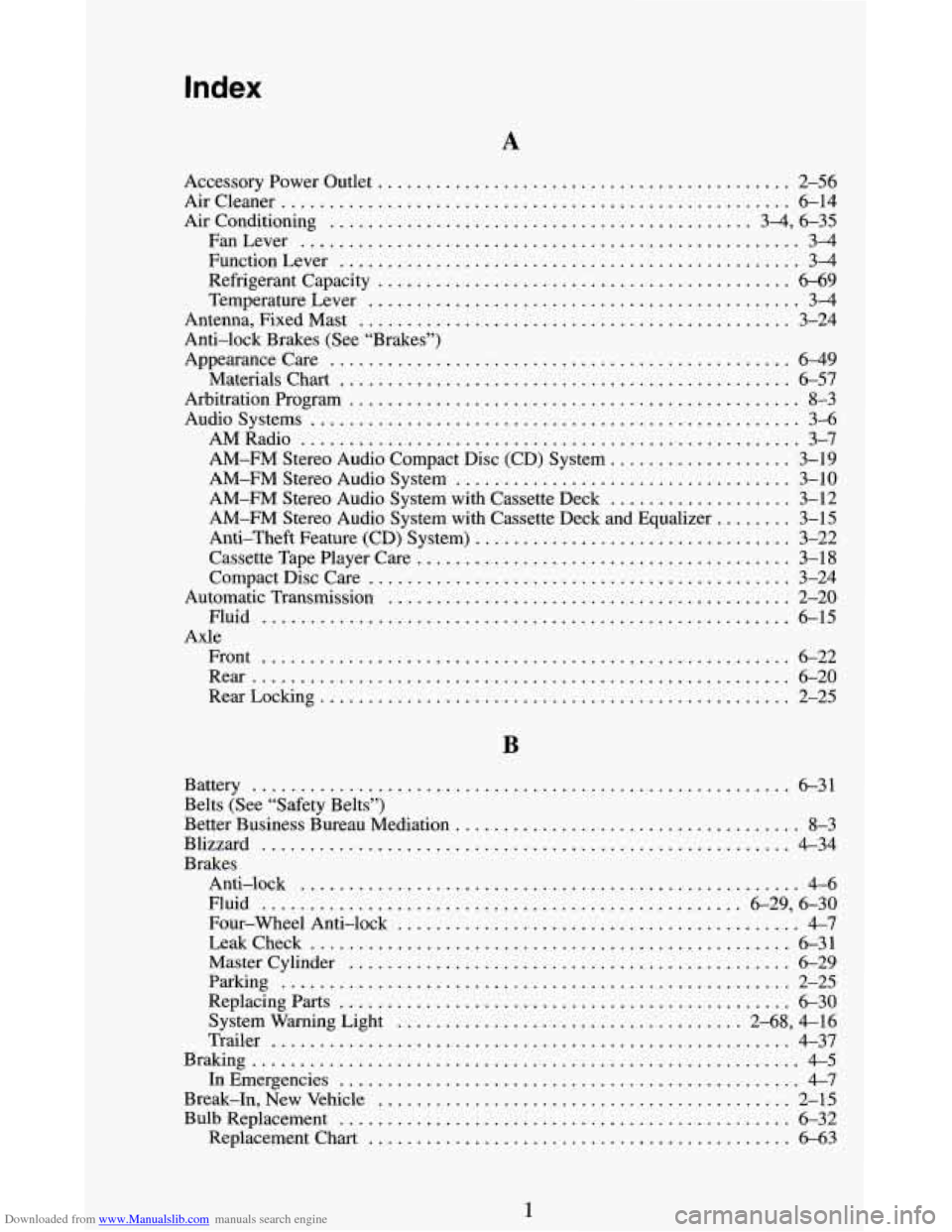
Downloaded from www.Manualslib.com manuals search engine Index
A
Accessory Power Outlet ........................................... 2-56
Aircleaner
..................................................... 6-14
Air Conditioning
............................................ 346-35
FanLever
.................................................... 34
FunctionLever
................................................ 34
Refrigerant Capacity
........................................... 6-69
Temperature Lever ............................................. 3-4
Antenna. Fixed Mast
............................................. 3-24
Anti-lock Brakes (See “Brakes”)
Appearancecare
................................................ 6-49
Materials Chart ............................................... 6-57
Arbitration Program
............................................... 8-3
Audiosystems
................................................... 3-6
AMRadio
.................................................... 3-7
AM-FM Stereo Audio Compact Disc (CD) System
................... 3-19
AM-FM Stereo Audio System with Cassette Deck
................... 3-12
AM-FM Stereo Audio System with Cassette Deck and Equalizer
........ 3-15
AM-FM Stereo Audio System ................................... 3-10
Anti-Theft Feature (CD) System)
................................. 3-22
Cassette Tape Player Care
....................................... 3-18
CompactDiscCare
............................................ 3-24
Automatic Transmission
.......................................... 2-20
Fluid
....................................................... 6-15
Axle Front
....................................................... 6-22
Rear
........................................................ 6-20
RearLocking ................................................. 2-25
........ 6-31 Battery ............................... .......
Belts (See “Safety Belts”)
Better Business Bureau Mediation
.................................... 8-3
Blizzard
....................................................... 4-34
Brakes Anti-lock
.................................................... 4-6
Fluid
.................................................. 6.29. 6.30
Four-wheel Anti-lock
.......................................... 4-7
Leakcheck
.................................................. 6-31
Mastercylinder
.............................................. 6-29
Parking
..................................................... 2-25
Replacingparts
............................................... 6-30
System Warning Light
.................................... 2.68. 4-16
Trailer ...................................................... 4-37
Braking
......................................................... 4-5
InEmergencies ................................................ 4-7
Break-In, New Vehicle
........................................... 2-15
Bulb Replacement
............................................... 6-32
Replacementchart ............................................ 6-63
1